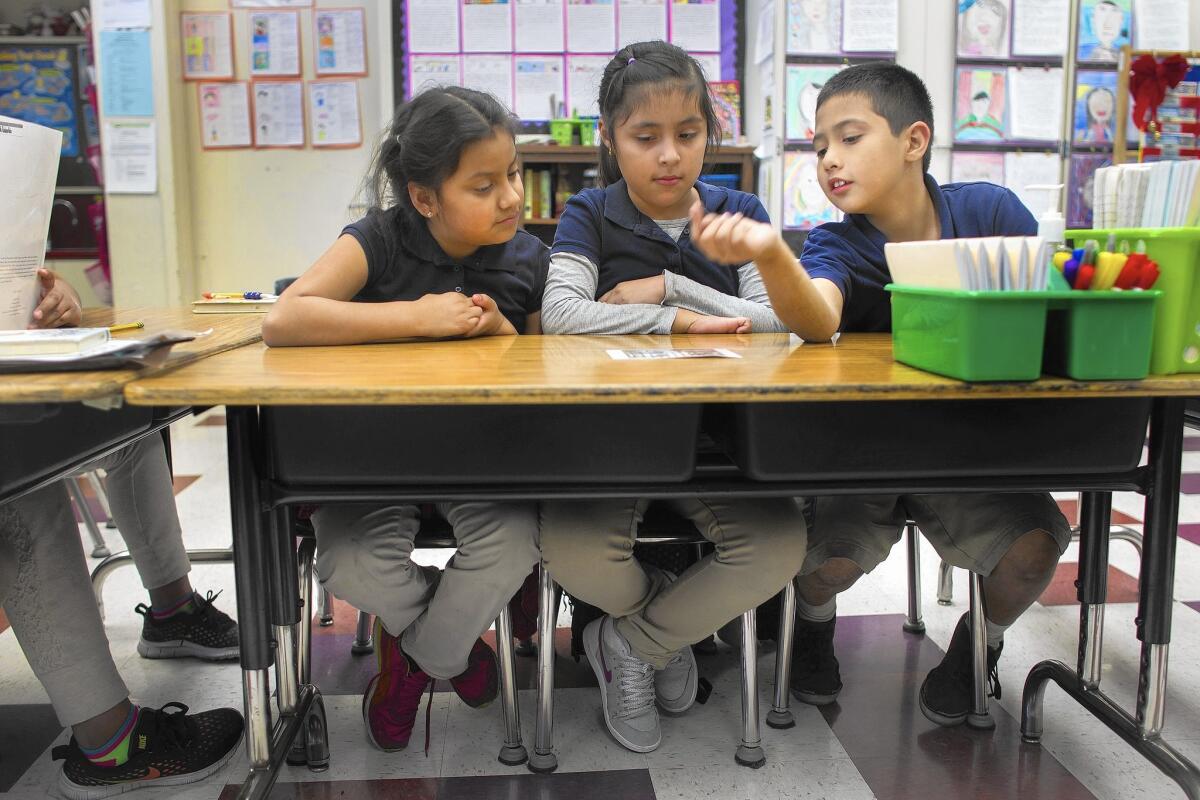Can two federal bills finally fulfill goals of No Child Left Behind?

- Share via
The No Child Left Behind law had an ambitious goal to reform America’s public schools 16 years ago: Every student, everywhere, would be academically successful by 2014.
That hasn’t happened, and the vast majority of schools that receive federal funds are now labeled as failures under the law.
“The current federal system has basically become meaningless in drawing a distinction between schools that are performing well and schools that are not,” said Keric Ashley, deputy superintendent for the California Department of Education.
That could change. Both houses of Congress have approved sweeping education bills, but the effort could fall short of becoming law because of political and policy hurdles.
The Senate’s Every Child Achieves Act, approved last week, as well as legislation passed by the House of Representatives, would return to the states broad authority over how to deal with low-performing schools.
At the same time, the bills maintain requirements for annual standardized testing in math and English in most grades, while also ordering states to report detailed data about student achievement.
But there are important distinctions between the House and Senate measures that ultimately could doom the effort.
The fundamental differences concern the amount of federal funding and the rules for using these dollars. The House bill, called the Student Success Act, caps education spending and allows states more freedom to reduce their own spending on schools without facing federal penalties. It also gives more freedom to states regarding which students will benefit from federal aid.
Just as crucially, the House bill would make it easier for federal money to follow low-income students who qualify for aid, regardless of what public school they attend. This approach has many supporters, but would fundamentally alter the purpose and distribution of federal funds, experts said.
That’s because current federal policy concentrates this aid, called Title 1, in schools with the highest percentages of low-income students. In L.A., for example, a school in which 20% of students come from low-income families would not receive Title 1 funding under today’s rules, leaving more funding available for a campus that is 80% low income. The House bill would eliminate that.
Critics say the House bill would, in effect, transfer money from lower-income to higher-income areas.
The House bill would represent a “turning away from the historic commitment of federal dollars to poor kids,” said Randi Weingarten, president of the American Federation of Teachers.
The House passed its bill largely along party lines, with Republicans closing ranks to provide a narrow majority.
Like the House, the Senate is in the hands of Republicans, but the bill from that chamber attracted bipartisan support, as noted by Sen. Lamar Alexander (R-Tenn.), who chairs the education committee.
“The Senate’s shown that not only is there broad consensus on the need to fix this law — remarkably, there’s also broad consensus on how to fix it,” Alexander said in a joint release with Sen. Patty Murray (D-Wash.). “This is the consensus: Continue the law’s important measurements of students’ academic progress but restore to states, school districts, classroom teachers and parents the responsibility for deciding what to do about the results of those tests.”
The legislation now goes to a conference committee, where lawmakers will work to reach common ground.
The Obama administration has signaled that the president could sign the Senate bill, but still wants revisions. Most importantly, the administration is calling for rules that compel states to act when low-performing schools fail to improve, said U.S. Secretary of Education Arne Duncan.
“This bill still falls short of truly giving every child a fair shot at success by failing to ensure that parents and children can count on local leaders to take action when students are struggling to learn,” Duncan said in a statement. “We cannot tolerate continued indifference to the lowest performing schools.”
Steps to please the administration would likely erode Senate support. At the same time, any revision of the House bill would mean having to exchange some Republican yes votes for Democratic ones.
In recent years, with Congress in partisan gridlock, Duncan has stepped in to promote favored policies with the lure of grants and exemptions from some rules and penalties.
Through this method, the administration has pushed states to adopt new learning goals, called the Common Core, and to adopt teacher evaluation systems that rely on student standardized test scores as one measure of effectiveness.
These efforts led to sweeping change across the country as well as backlash against the learning standards and against the amount and use of testing that was first required by the No Child Left Behind Act, a bipartisan bill signed by President George W. Bush.
Both current bills make it clear that states can establish their own learning goals. And there’s no mandate for teacher evaluations — the challenge of developing fair performance reviews has sparked disputes across the political spectrum.
“It’s helpful to put some of these issues behind us,” said Mike Petrilli, a policy expert who has supported key Duncan policies.
“The aggressive federal role at this point is hurting more than helping the reform movement, causing a backlash from the left and the right,” said Petrilli, president of the Washington, D.C.-based Fordham Institute.
Petrilli and Weingarten are among those with strong disagreements on education policy — and among those who are currently hopeful.
Said Weingarten: “This is the first time that we are close to getting it right.”
[email protected]
Twitter: @howardblume
More to Read
Sign up for Essential California
The most important California stories and recommendations in your inbox every morning.
You may occasionally receive promotional content from the Los Angeles Times.











